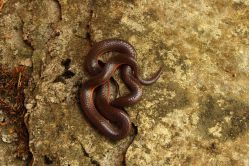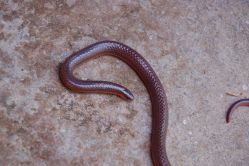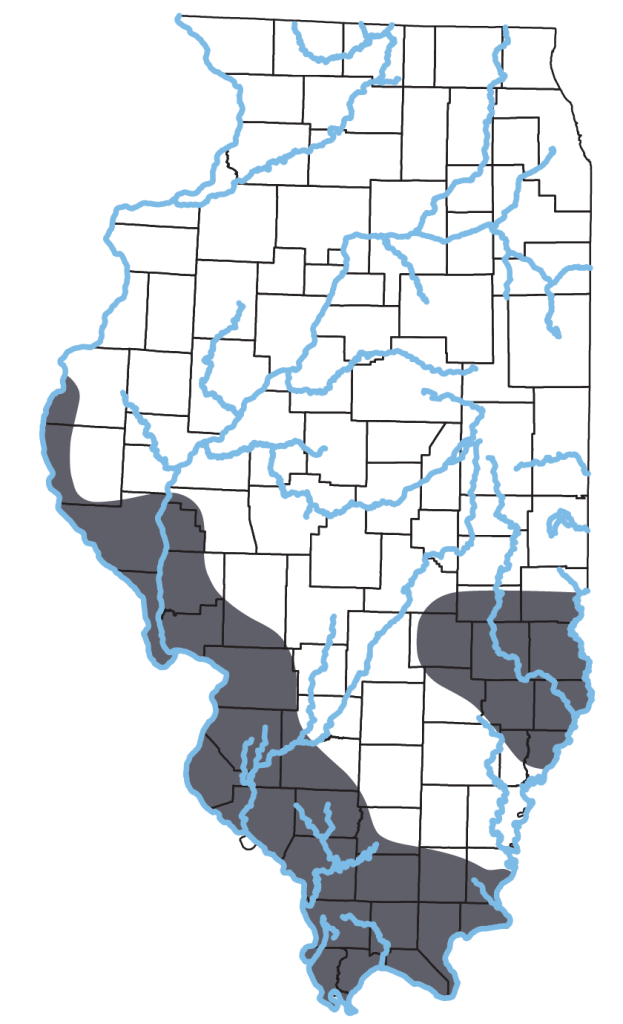Carphophis amoenus (Say, 1825)


Key Characters: Pointed head; spine-like tail tip; smooth dorsal scales; divided anal plate.
Similar Species: Smooth Earthsnake, Dekay’s Brownsnake, Red-bellied Snake. See the Key to Snakes of Illinois for help with identification.
Subspecies: Two subspecies are currently recognized, Midwestern Wormsnake, C. a. helenae (Kennicott, 1859) and Eastern Wormsnake, C. a. amoenus. Only the former inhabits Illinois. Smith (1961) considered the populations in southern Illinois to be C. a. helenae and those along the middle Mississippi River counties to be the Western Wormsnake, C. vermis, which was considered a subspecies of C. amoenus at the time. It is unclear whether the Western Wormsnake inhabits western Illinois.
Description: A small (up to 35 cm TL) wormlike burrowing snake with a brown back and pink belly. The pink color extends onto the first scale row. The two colors are more sharply contrasting in juveniles.
Habitat: Wooded areas, usually those with rocky soils.
Natural History: Most mating probably occurs in the fall with eggs laid the following June. Clutch size is normally 2-5 eggs and hatching takes place in August or September. Hatchlings range in size from 7 to 12 cm TL. Worm snakes feed almost entirely on earthworms. The main predators are other snakes.
Status: Locally abundant.
Etymology: Carphophis – karphos (Greek) meaning ‘any dry particle’, chaff, straw; ophios (Greek) meaning serpent, reptile; amoenus – (Latin) meaning pleasing, delightful; helenae – a patronym for Miss Helen Teunison, one of the collectors of the types. Note the spelling of Teunison. This is as it was spelled in the original publication, although later authors changed it to Tennison– see Davis & Rice 1883. List of Batrachia and Reptilia of Illinois. Bulletin of the Chicago Academy of Sciences. vol. 1, no. 3, for example).
Original Description: For amoenus, Say, T. 1825. Descriptions of three new species of Coluber, inhabiting the United States. Journal of the Academy of Natural Sciences Philadelphia; for helenae, Kennicott 1859. Notes on coluber calligaster of Say, and a description of a new species of Serpents in the collection of the north Western University of Evanston,Ill. Proc. Acad. Nat. Sci. Philadelphia 11: 98-100
Type Specimen: Not designated for either.
Type Locality: Not stated for amoenus, “Monticello, Mississippi” and “Southern Illinois (abundant in the woods)” for helenae.
Original Name: Coluber amoena Say, 1825; Celuta helenae Kennicott, 1859.
Nomenclatural History: Kennicott (1859. Proc. Acad. Nat. Sci. Philadelphia 11: 98-100) named the Midwestern Wormsnake as a full species, Celuta helenae. It was moved to Carphophiops and later reduced to a subspecies by Jan (1865. Iconographie générale des ophidiens. 12. Livraison. J.B. Bailière et Fils, Paris). Kennicott also listed Celuta amaena in his 1855 “Catalogue of Animals Observed in Cook County”, although this species does not come near Cook County. Davis & Rice (1853) listed this species in their Illinois list as Carphopiops helenae.


